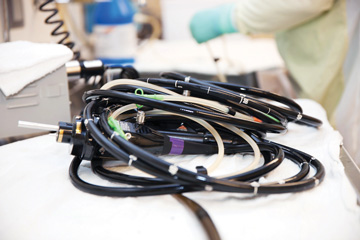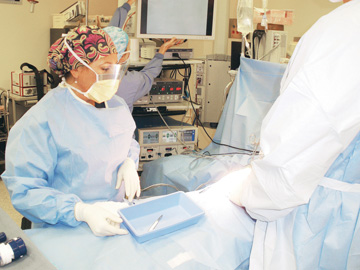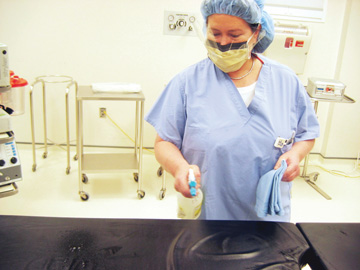Infections can be catastrophic. They're potentially deadly to patients and staff, expensive to treat, can force a second surgery and are unpleasant to litigate. Use this quiz to see if you're up to date on the
latest infection prevention practices and see what experts have to say about the advances that help patients and staff stay healthy and safe.
1. Immediate point-of-use treatment and the prompt transport of surgical instruments to sterile processing lessens the importance of manual cleaning before the disinfection/sterilization process.
- a. True
- b. False
- Reveal
Answer: b
Treating soiled tools at the bedside with an enzymatic spray or foam and keeping them moist for the duration of the case are frequently overlooked components of comprehensive instrument care.
Point-of-use treatment removes bioburden in a far easier fashion than if it's left to harden on instruments by the time they arrive in the sterile processing department (SPD). And keeping instruments wet loosens debris
that remains while they sit waiting for treatment by a reprocessing technician. While point-of-use treatment is overlooked by some, it's often overvalued by those who do employ the practice, says Benjamin D. Galvan, MLS(ASCP)CM,
CIC, an infection preventionist at Tampa General Hospital. "Some facilities consider the point-of-use treatment as a substitute for the manual cleaning process, when in fact they are two different steps," says Mr. Galvan.
"Even when you pre-treat properly — wiping instruments after they're used and soaking them before they arrive in decontamination — you're not really cleaning everything. Instruments that arrive in SPD after being treated,
while in much better shape than not having been wiped down, still aren't ready to go straight to the sterilization process."
Close
2. Healthcare workers on the wrong end of a needlestick are at risk of contracting HIV, hepatitis B and hepatitis C. Which is the most likely infection to occur?
- a. hepatitis B
- b. hepatitis C
- c. HIV
- Reveal
Answer: a
Many healthcare workers are most concerned about hepatitis C or HIV if they are injured by a syringe, scalpel or suture, but they are less likely to suffer those conditions than a hepatitis
B infection, says Mr. Galvan. Surgical personnel should obviously be worried about all bloodborne pathogens, but there is a 30% risk of percutaneous transmission of hepatitis B, compared to a 1.8% chance of transmission
of hepatitis C and only a 0.3% risk of transmission of HIV. The Association for periOperative Registered Nurses (AORN) says as many as 90% of sharps injuries go unreported. AORN stats show that about 385,000 hospital workers
suffer one each year — and it's believed injuries occur in as many as 15% of all surgeries in the U.S. More than half of the injuries are estimated to be preventable. "You should never rush when you're dealing with sharps
and should make sure to use products designed to keep you safe, such as plastic passing trays, blunt-tipped suture needles and retractable scalpels when appropriate, as well as closed disposal containers," says Mr. Galvan.
Close
3. What are the two most frequently missed steps when instruments are cleaned prior to disinfection and sterilization?
- a. proper transport and cleaning
- b. drying and inspection
- c. rinsing and safe repackaging
- Reveal
Answer: b
It's not unusual to see instruments not get dried properly and go uninspected before they go into the sterilizer. These two critical components of proper instrument care are often skipped,
according to Luci Perri, RN, BSN, MSN, MPH, CIC, FAPIC, CSPDT, owner and president of Infection Control Results, a Charlotte, N.C.-based consulting company. In addition to being skipped at times, sometimes they're occasionally
performed in the wrong order. Instruments should be dried before they're inspected. "Water distorts the image of whatever might be on the instruments, making it difficult to see bioburden or damage," says Ms. Perri. "After
instruments come out of the washer, they should be dried first, then inspected. After that you can go ahead and package them for sterilization."
Ms. Perri believes many SPD workers simply don't know they're supposed
to be drying and inspecting prior to sterilization. "They're the two most frequently missed steps taking place in outpatient settings," she says. "They're important, because if the inspection shows biological soil remains,
the instruments should be sent back to be rewashed. If damage is detected, the instruments should be repaired or replaced."
Close
.svg?sfvrsn=be606e78_3)



.svg?sfvrsn=56b2f850_5)